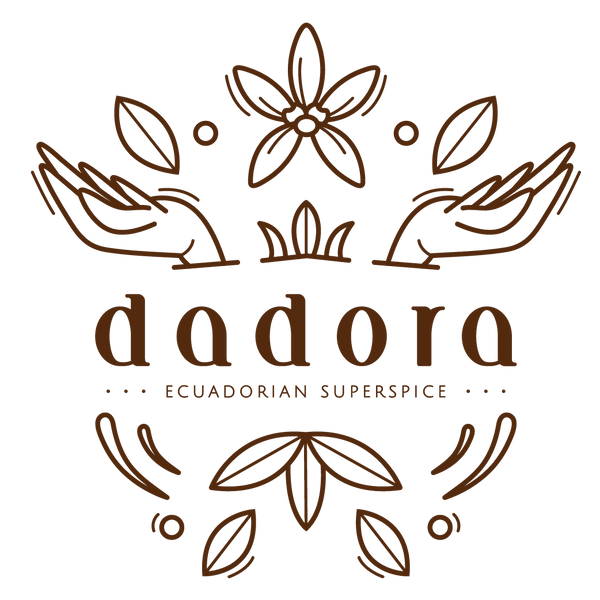Vanilla beans are precious — and like any natural ingredient, they deserve a little care. Whether you’re using them to make extract, bake pastries, or infuse syrups, proper handling ensures that every bean you buy stays fragrant, fresh, and full of flavor.
At Dadora Vanilla, we grow and cure our beans in Ecuador’s tropical climate before carefully vacuum-sealing them to lock in moisture and aroma. Below are a few key tips to help you get the most out of your vanilla beans once they arrive at your door.

When Your Vanilla Beans Arrive
If they arrive cold or even frozen:
Don’t worry — that’s perfectly normal in cooler climates. Simply keep your beans sealed in their pouch and let them come to room temperature slowly. Sometimes a white “frost” may appear on the surface as they thaw — this is natural vanillin crystal formation, not mold. It will fade as the beans warm up.
Should You Clean Your Vanilla Beans?
In most cases, there’s no need to wash your vanilla beans when they arrive. During the curing process, the pods are heated (blanched early on and sun cured later on) and naturally develop protective oils that prevent bacterial growth. Washing them in water or alcohol can remove some of those oils and dry out the pods prematurely.
However, if you plan to use your beans for frosting, ice cream, or any uncooked recipe, you can gently wipe them with a damp towel or rinse briefly right before use — similar to how you would clean fresh produce.
Storing Vanilla Beans
Keep them sealed: Vanilla beans last longest in their original vacuum-sealed packaging.
Cool, dark, and dry: Store them in a cupboard away from direct sunlight or heat sources.
Avoid the fridge or freezer: Cold air can dry the beans and encourage crystallization.

If you’re making extract, it’s best to prepare your alcohol and bottles before your beans arrive. That way, you can submerge the beans immediately — which also happens to be one of the safest and most effective long-term storage methods. The alcohol acts as a natural preservative.
How to Tell if Your Vanilla Beans Have Gone Bad
We pack our product ourselves for you ensuring bad beans would never be sent to you. But in case you purchase from a re-seller promising $8/ oz here are some tips.
Vanilla beans are surprisingly resilient thanks to their thick skin and vanillin oil. Still, spoilage can occur if they’re exposed to moisture or air for too long.
Signs of bad beans:
Slimy or sticky surface (not oily)
Strong sour or musty odor
Visible fuzzy mold that doesn’t disappear with warmth
If you see just a small spot of mold on an otherwise firm bean, it can often be cut off — similar to how you’d remove a small mold patch on firm produce like a carrot or cabbage. But if you’re ever unsure, it’s safest to discard the affected bean.
Not Everything White Is Mold
Vanilla beans are full of naturally occurring oils and vanillin compounds that can create appearances similar to mold — but are totally harmless (and even a good sign!).
Vanillin crystals (“vanilla frost”): White, web-like, and dissolves with gentle warmth. Indicates a vanillin-rich bean.
Vanilla butter: Light-colored and soft, melts when touched or warmed.
Cold speckles: Tiny off-white dots caused by chilled oils. They wipe away easily.
You can test by rubbing the spot gently between your fingers. If it feels buttery and smooth, it’s not mold. Mold will crumble or stay powdery.
Other Natural Imperfections
Each bean tells its own story. You might notice slight abrasions where farmers tied bundles together or even faint “brands” — small tattoos burned into the skin by farmers to identify their harvests and prevent theft. These markings are completely natural and do not affect the quality or flavor. You won't find tattoos our beans as we have full control over every step from cultivation to harvest to packaging.
When Making Extract
If you see small white streaks or particles floating in your extract over time, don’t panic. These are usually vanillin oils or bits of the pod breaking down — a normal part of the extraction process. Some makers strain their extract for clarity, while others keep the specks for a rustic, homemade look. Either way works beautifully.
The Dadora Promise
Every Dadora vanilla bean is hand-inspected, naturally cured, and vacuum-sealed at origin to preserve its integrity from our farm in Esmeraldas, Ecuador, to your kitchen. We never pre-rinse or add alcohol before packaging — ensuring that what you receive is pure, natural vanilla in its most authentic form.
If you ever have a question about your beans or need help identifying something unusual, feel free to reach out to our team at sales@dadoravanilla.com. We’re always happy to help.

